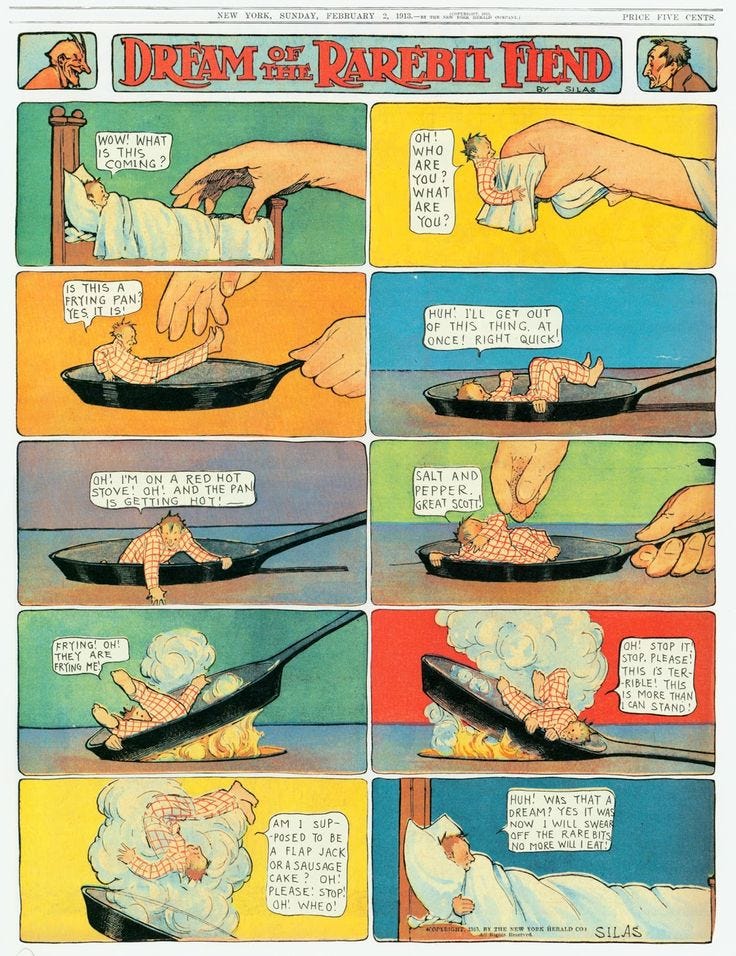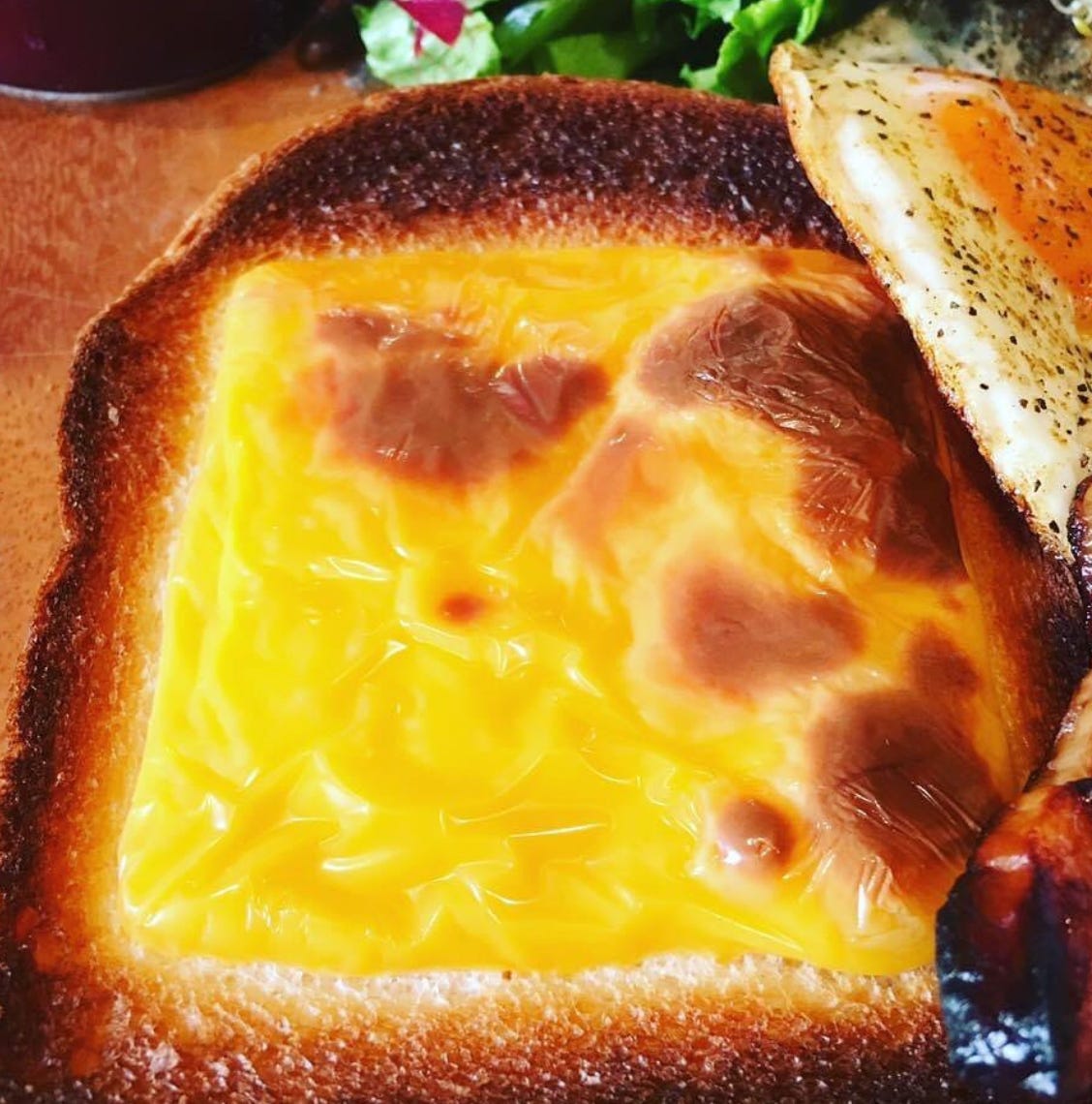Notable Sandwiches #31: On the Interpretation of Cheese Dreams
What does it mean when you dream about cheese?
Welcome back to Notable Sandwiches, the series in which I, alongside my editor David Swanson, trip merrily through the profoundly odd and ever-changing document that is Wikipedia’s List of Notable Sandwiches. This week: a Depression-era American favorite, the Cheese Dream.
The Cheese Dream, in and of itself, is the simplest of sandwiches: buttered bread, with a slice of American cheese on it, broiled until the top layer of the cheese is browned and toasty. If it’s a dream, it’s an unadorned one—that out of meagerness can come indulgence. And yet, it dates back more than a century, and has traveled the same path that so many foods have, from faddish, novel glory to nostalgic throwback. What once was deemed a “dainty” is now “trashy,” according to one raucous and annoying podcast. It’s a familiar erosion, but, like most dishes that have traveled down the decades to remain among us, the Cheese Dream’s intersections with human lives garnish it with new interest.
The most notable thing about this humble sandwich is the name. Despite some assiduous research, I haven’t been able to pinpoint who first coined the oneiric moniker, although the association between cheese and dreams goes back a very long time.
The Sword and the Sandwich is a newsletter about serious extremism and equally serious sandwiches. Please consider supporting this work with a paid subscription:
The association between dreaming and cheese is complex. For many years, folk wisdom has held that the eating of cheese, like other rich foods, shortly before bedtime could lead to wild and disturbing dreams. Examples of this link abound in popular culture: in “Dutch Fairy Tales For Young Folks,” a 1918 collection by folklorist William Elliot Griffis, issues forth a fearsome warning:
Now some dreams may be pleasant, but cheese-dreams were not usually of this sort. The dreamer thought that a big she-horse had climbed upon the bed and sat down upon his stomach. Once there, the beast grinned hideously, snorted, and pressed its hoofs down on the sleeper's breast, so that he could not breathe or speak.…
In those days, instead of seeking for the trouble inside, or asking whether there was any connection between nightmares and too hearty eating of cheese, the Dutch fathers laid it all on the goblins.
According to the British academic Gillian Beer, Victorians viewed indigestion as a principal source of bad dreams, with cheese often a primary culprit. She notes that Ebenezer Scrooge, when confronted with the ghost of Jacob Marley in A Christmas Carol, at first accuses him of being merely a “crumb of cheese” transfigured into nightmare. A similar dramatic connection formed the entire premise of a work from famed cartoonist Winsor McCay, better known for the art nouveau comic-strip wonderland Little Nemo in Slumberland.
One of McCay’s first successful comic strips, Dream of the Rarebit Fiend, features a succession of characters dreaming wild, revealing dreams; their only commonality is a habit of eating Welsh Rarebit, which usually consists of cheese sauce on toast, just before bedtime. There is even a smidgeon of scientific evidence to support the notion of cheese nightmares: according to a study commissioned by the now-defunct British Cheese board, Blue Stilton in particular imparts vivid, nearly hallucinogenic dreams. According to the second-century author Artemidorus, in his dream-interpretation opus Oneirocritica, dreaming of cheesecakes or of cheese indicates deceit.
So why name a toothsome little snack after a literal nightmare, unless you truly despise your guests? Without having tracked down the originator of the recipe, it’s difficult to know with any certainty. But while Artemidorus might have disdained the meaning of cheese dreams—that is, dreams of cheese, rather than those caused by cheese—other more recent guides to the mysteries of sleep have been far more positive in their interpretations. From the nineteenth century on, book after book states that to dream of cheese signifies plenty. According to The Countess of Blessington’s True Interpretation of Dreams, Visions, and Omens of the Wedding-Day, Etc., published in 1861:
“Dreaming of sitting on a chair, denotes great respect, Chains sheweth imprisonment, bad news, death, and neglect.
To become a chaplain shows elevation high, Cheese signifies good-luck, to make it is to die.”
An 1851 guide to dreams claims that to have cheese in one’s dreams indicates profit; an 1876 dream manual by the pseudonymous “Norwood Gipsy” echoes Artemidorus, saying, “To dream you eat cheese, signifies profit and gain in trade—in love deceit.” According to a more recent guide, 2006’s The Little Book of Dream Symbols by Jacqueline Towers, “If you see yourself eating cheese, celebrate—for it means that you will be successful in love.”
As a sandwich, the Cheese Dream is so plain that perhaps the eating of it denotes future profit by means of present thrift. According to Betty Crocker’s Picture Book from 1950, the sandwich was “invented by boarding school girls,” a questionable origin story that has hardened into orphan fact. The earliest recipe I could find dates back to 1908, by a war correspondent named Emma Paddock Telford who once traversed the Balkan mountains in an oxcart and also wrote a syndicated “Domestic Science” newspaper column. The recipe is essentially a proto-grilled-cheese, and is as follows:
“This is a popular supper relish for Sunday night. Spread slices of bread with good sweet butter, and lay thin slices of cheese between every two slices of bread, sandwich fashion. Put into a rather hot oven until the cheese melts and the buttered bread becomes crispy and altogether delicious.”
Early recipes for cheese dreams specified closed sandwiches, and are prominently featured on menus for luncheons, suppers and schools. By the mid-1930s, perhaps due to the parsimony imposed by the Great Depression, the top slice of bread seems to have disappeared, and the butter is augmented with spice (“Thin bread is spread with soft cheese, grilled to a golden brown, and dusted with paprika,” read an ad from 1933). It stayed in that form—along with other Depression classics like liver and onions, stewed prunes, and savory gelatins—for the rest of the century, and beyond; although the Dream is often bolstered with bacon, olives, pickles, tomato sauce and other preserved savories to make bread stretch. In James Beard’s Simple Food, the fabled gourmand’s version called for “a slice of tomato on bread, covered with American cheese which was melted under the broiler and then graced with crisp bacon.” Mentions in the twenty-first century seem weighed-down with nostalgia, or feel forced and rehabilitated, adding confections like bechamel, or maple syrup.
When you dream of cheese, you may be deceived, or you may profit; you may discover a hideous horse on your chest. Or you may simply have supper—a savory snack for you alone, or for a multitude. Don’t be a tyromancer—one who, in the days of the Greeks, practiced divination with cheese—and think too deeply. Just slice, spread, broil, and bite.









My grandmother, z"l, would make cheese dreams with french toast: a piece of wonderbread, dredged in egg, fried in margarine on the stove, topped with velveeta, and run through the toaster oven. Nine year old Josh loved it.
i like pesto to "butter" one of the insides on a toasty cheese sammy~ & once it's all toasty & melty i shove some fresh sprouts on it & serve with a big ole garlicky kosher dill pickle... at the right moment, this can really feel like livin' the dream~